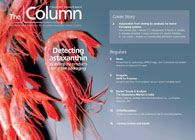Environmentally friendly eggs
Organophosphate flame retardants (OPFRs) are used in a variety of commercial products worldwide, however, little is known about their environmental and health impacts.

Organophosphate flame retardants (OPFRs) are used in a variety of commercial products worldwide, however, little is known about their environmental and health impacts.
A team based in Canada has developed a method for examining their impact by analysing 13 herring gull eggs from the Channel-Shelter Island colony at Lake Huron.1 The method is based on a two-step sample extraction followed by liquid chromatography–electrospray ionization(+)-tandem mass spectrometry. Three OPFRs were detected in the eggs: tris(2-chloroisopropyl) phosphate (4.1 ng/g wet weigh, ww), tris(2-chloroethyl) phosphate (0.6 ng/g ww) and tris(2-butoxyethyl) phosphate (2.2 ng/g ww).
Further study is required but this novel method is highly suitable for the analysis of environmentally relevant OPFRs as only 1 g of egg homogenate is needed for successful analysis. This research contributes towards our need for information about the prevalence of OPFRs in the environment.
1 Shaogang Chu et al., Journal of Chromatography A, 1220, 169–174 (2012).
This story originally appeared in The Column. Click here to view that issue.
Determining Enhanced Sensitivity to Odors due to Anxiety-Associated Chemosignals with GC
May 8th 2025Based on their hypothesis that smelling anxiety chemosignals can, like visual anxiety induction, lead to an increase in odor sensitivity, a joint study between the University of Erlangen-Nuremberg (Erlangen, Germany) and the Fraunhofer Institute for Process Engineering and Packaging (Freising, Germany) combined behavioral experiments, odor profile analysis by a trained panel, and instrumental analysis of odorants (gas chromatography-olfactometry) and volatiles (gas chromatography-mass spectrometry).
Investigating 3D-Printable Stationary Phases in Liquid Chromatography
May 7th 20253D printing technology has potential in chromatography, but a major challenge is developing materials with both high porosity and robust mechanical properties. Recently, scientists compared the separation performances of eight different 3D printable stationary phases.
Detecting Hyper-Fast Chromatographic Peaks Using Ion Mobility Spectrometry
May 6th 2025Ion mobility spectrometers can detect trace compounds quickly, though they can face various issues with detecting certain peaks. University of Hannover scientists created a new system for resolving hyper-fast gas chromatography (GC) peaks.

.png&w=3840&q=75)

.png&w=3840&q=75)



.png&w=3840&q=75)



.png&w=3840&q=75)









